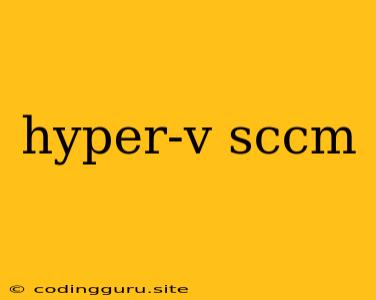Integrating Hyper-V with SCCM: A Powerful Duo for IT Infrastructure Management
Hyper-V and System Center Configuration Manager (SCCM) are two powerful tools in any IT professional's arsenal. When combined, they create a robust infrastructure management solution capable of streamlining deployments, managing updates, and simplifying overall system administration. This article explores the benefits and functionalities of integrating Hyper-V with SCCM, outlining how this synergy can enhance your IT operations.
What is Hyper-V?
Hyper-V is Microsoft's virtualization platform for Windows Server operating systems. It allows you to create and manage virtual machines (VMs) on physical hardware, enabling you to consolidate workloads, optimize resource utilization, and improve flexibility in your IT environment.
What is SCCM?
SCCM, previously known as System Center Configuration Manager, is a comprehensive IT management platform designed to deploy software, manage updates, and monitor systems across your network. SCCM facilitates centralized control and automation, helping you streamline processes and reduce administrative overhead.
Why Integrate Hyper-V with SCCM?
Integrating Hyper-V with SCCM offers several key benefits:
-
Simplified VM Management: SCCM enables you to manage your Hyper-V VMs alongside your physical machines, eliminating the need for separate management tools. You can perform tasks like software deployment, operating system patching, and inventory reporting for both physical and virtual machines within a single console.
-
Automated Deployment and Patching: SCCM allows you to automate the deployment of operating systems and applications to your Hyper-V VMs. This automation streamlines deployments, reduces manual effort, and ensures consistency across your virtual infrastructure.
-
Centralized Monitoring and Reporting: SCCM provides comprehensive monitoring and reporting capabilities, allowing you to track the health and performance of your Hyper-V VMs alongside other systems in your network. This centralized view offers valuable insights into your virtual infrastructure and facilitates proactive problem solving.
-
Simplified Update Management: SCCM helps you manage software updates for your Hyper-V VMs, ensuring that they receive timely security patches and feature updates. You can create automated update schedules, target specific VM groups, and track update status to maintain a secure and up-to-date virtual environment.
How to Integrate Hyper-V with SCCM
Integrating Hyper-V with SCCM involves several steps:
-
Prepare Your Environment: Ensure that your SCCM server has the necessary prerequisites for managing Hyper-V, including the appropriate integration packs and configuration settings.
-
Configure SCCM for Hyper-V Management: Configure your SCCM server to manage Hyper-V VMs by specifying the location of your Hyper-V hosts and enabling the relevant management features.
-
Discover Hyper-V VMs: Once SCCM is configured, it will automatically discover your Hyper-V VMs, adding them to the managed inventory.
-
Deploy Software and Updates: Use SCCM's deployment tools to distribute software and updates to your Hyper-V VMs, just like you would with physical machines.
Tips for Successful Integration
- Thorough Planning: Before integrating Hyper-V with SCCM, plan carefully, considering your specific needs and infrastructure.
- Pilot Deployment: Test your configuration in a pilot environment before rolling it out to your entire production infrastructure.
- Regular Monitoring and Maintenance: Regularly monitor your integrated environment for any issues and ensure that both Hyper-V and SCCM are up-to-date.
Examples of Integration Use Cases
- Operating System Deployment: Automatically deploy a new Windows Server operating system to multiple Hyper-V VMs simultaneously using SCCM's deployment tools.
- Patch Management: Schedule automatic updates for your Hyper-V VMs through SCCM, ensuring all systems are patched with the latest security fixes.
- Software Distribution: Distribute software applications to your VMs, automating installation and configuration for consistent deployments.
Conclusion
Integrating Hyper-V with SCCM offers a powerful combination for managing your virtual infrastructure, providing centralized control, automation, and comprehensive management capabilities. This integration streamlines deployments, optimizes resource utilization, and simplifies administrative tasks. By leveraging the power of these two tools together, you can enhance the efficiency and security of your IT environment while maximizing resource utilization and minimizing administrative overhead.
